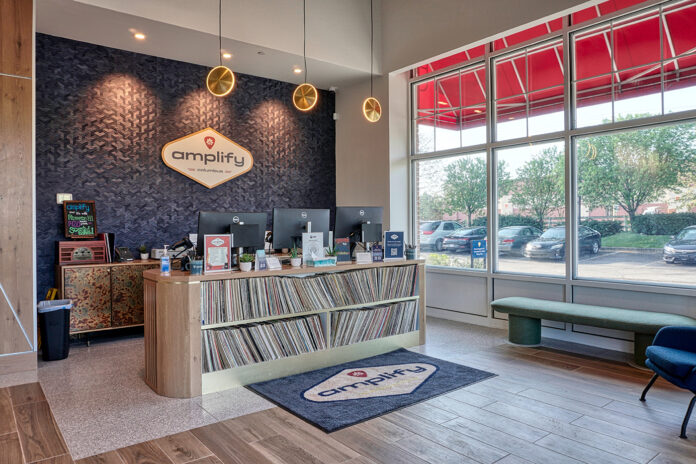
Stroll down any of the placid, leafy avenues in Columbus, Ohio, and inevitably you’ll catch sight of an emblem of the state. Maybe it’s a flag on a porch, a bumper sticker, or an Ohio State University hat perched atop a smiling face. Residents’ immense pride in the Buckeye State is unwavering, undeniable, even unavoidable.
Ohioans love Ohio things, so it’s fitting one of the most successful companies in the state’s fledgling cannabis industry is Buckeye Relief, a homegrown vertical operator with a ubiquitous brand and a pair of popular stores in Columbus and Cleveland.
“There’s a feeling of being underdogs, particularly in Cleveland, that really stirs people’s pride here,” said Heather Rayburn, Buckeye Relief’s creative director. “That pride definitely translates to how Ohioans support local businesses.”
Rayburn is a longtime Cleveland resident and the wife of Andrew Rayburn, one of Buckeye Relief’s co-founders and a storied Midwest entrepreneur. Heather Rayburn’s background as an art historian, curator, and branding executive in New York City underpins the meticulously considered design direction of the company’s Amplify stores.
Tucked in the northeast corner of Columbus, Amplify serves hundreds of patients per day and brings the contemporary flair of a more mature market’s adult-use dispensary design and execution to Ohio’s burgeoning medical market.
“We really strived to create a memorable experience for everyone who walks in,” Heather Rayburn explained. “The way I see it, your brand isn’t just the design. It’s also how you’re greeted, how quickly you’re taken care of, how comfortable you feel. It’s the impression you’re left with.”
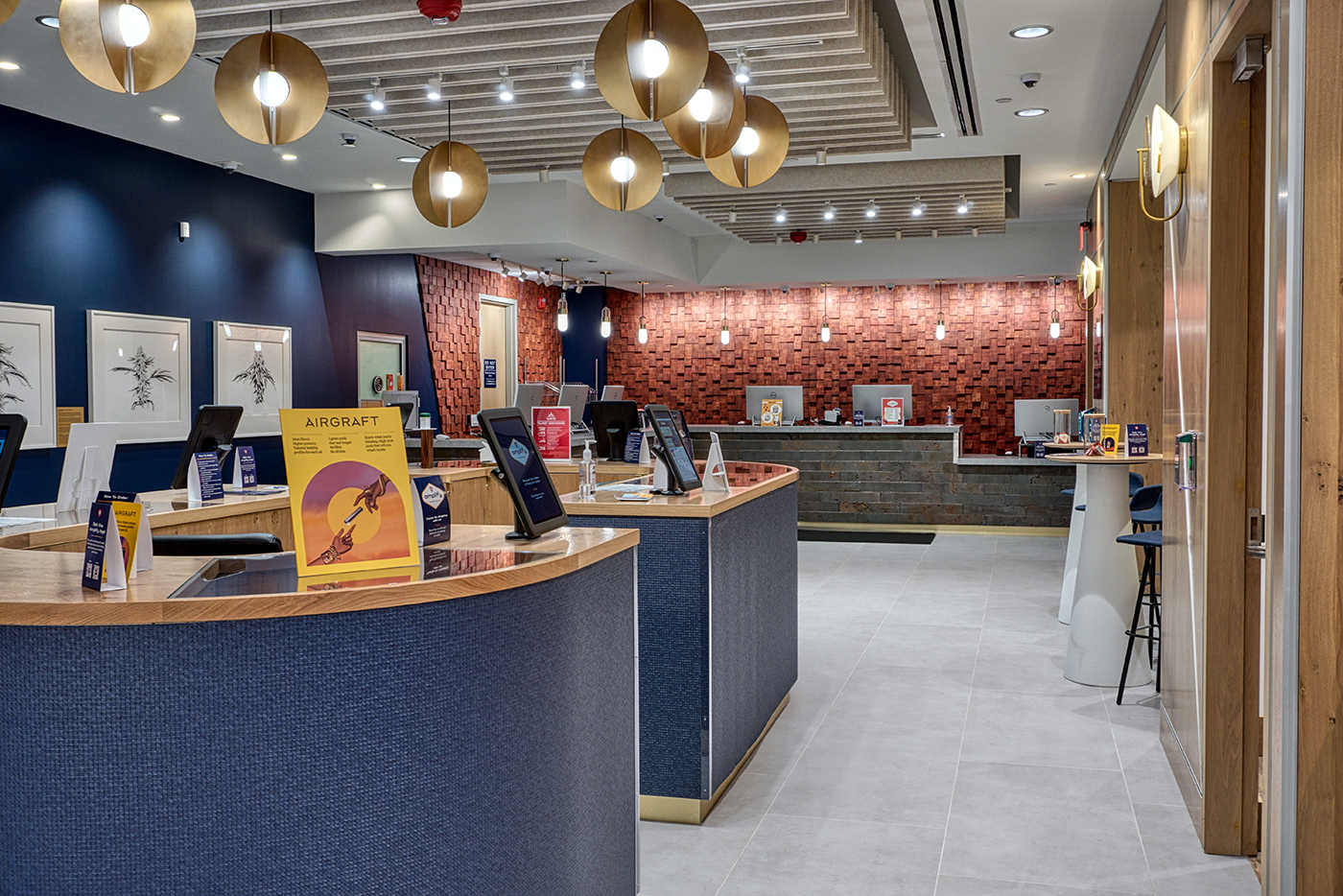
As the primary inspiration for Amplify, she chose the motto of the Cleveland Clinic’s world-renowned art program, which she paraphrased as “medicine heals the body, and the arts heal the human spirit.”
The name Amplify, she explained, is a double entendre referring to amplifying health while also evoking the spirit-nourishing power of music. “Cannabis heals the body, and we wanted our space to use various artistic elements to heal the soul,” she said.
Subtle visual references to the philosophy abound throughout the space. The reception desk sits atop a shelving unit brimming with vinyl records, while light bulbs dangle from above like microphones in a recording studio. One of the point-of-sale stations is shaped like a musical note, and the consultation tables bear glass jars filled with branded guitar picks. One day, regulation permitting, Rayburn would like to screen rock ‘n’ roll documentaries in the store.
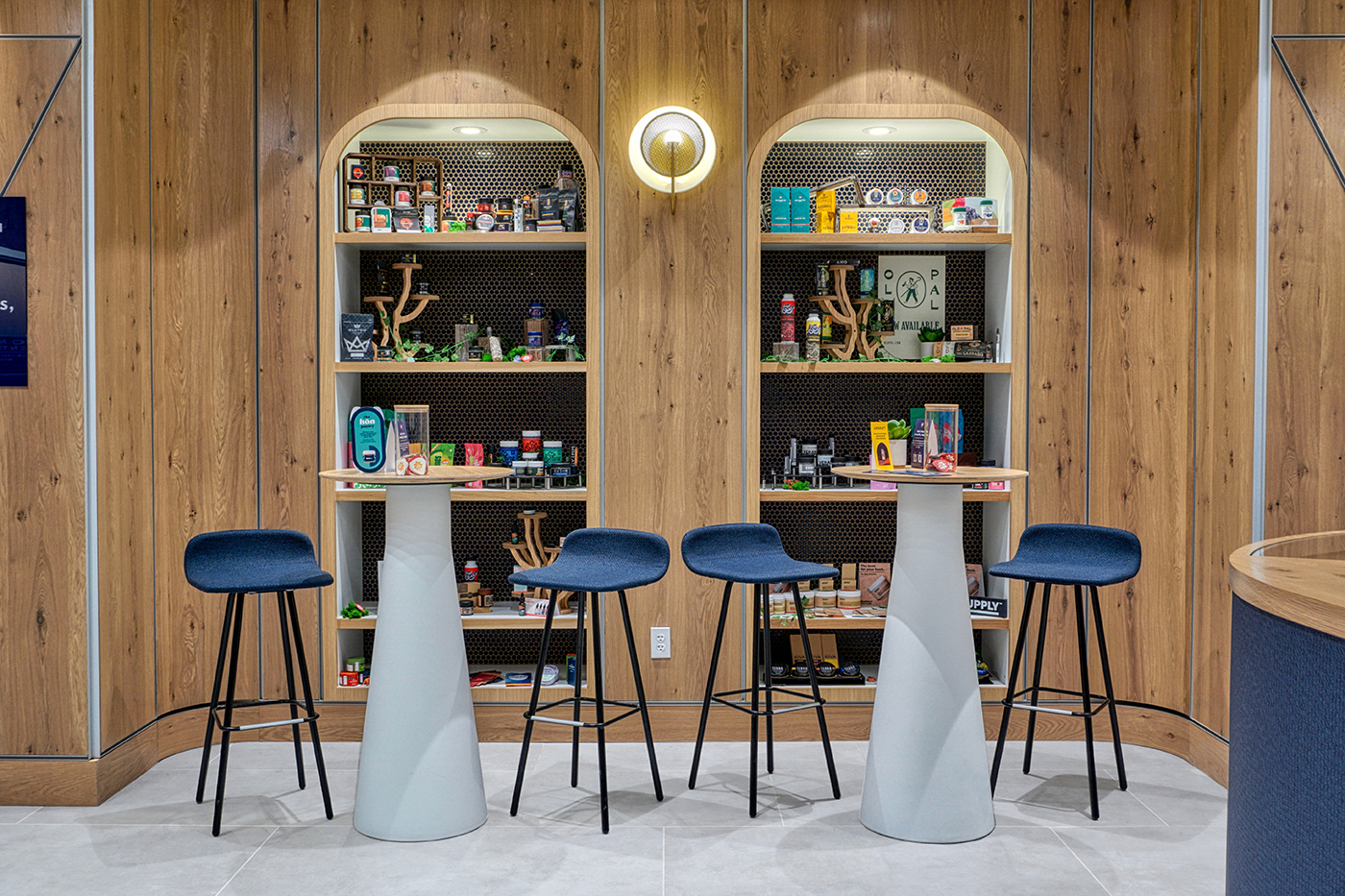
When designing the space, she was cognizant of the demographic breadth of Amplify’s patient base, noting customers span all ages, abilities, ethnicities, and genders. “We wanted there to be a certain gender fluidity to the design,” she explained. “The color palette is predominantly masculine, but the space has lots of soft edges and gold accents that balance that out. The goal was to make a comfortable, elegant space that didn’t feel like a doctor’s office but thoughtfully considered our patients’ needs.”
Choosing the right furniture was important to achieve that effect. In a medical market, Ohio’s stores must cater to a wide variety of physical challenges. Amplify has a collection of funky, curvaceous velvet chairs, couches, and stools at different heights to provide patients with spaces where they can relax without discomfort or self-consciousness.
The combination of the music references, retro furniture, Rayburn’s botanical drawings on the wall, and the abundant supply of quality products leaves visitors with the impression of a classic rock star’s living room.
“We didn’t design this store exclusively for our customers. It’s for our employees, too,” said Rayburn. “They spend so much time here, so if you create a beautiful space they’re proud of, it helps morale and productivity. Some of them have even told me they want to move in here.”
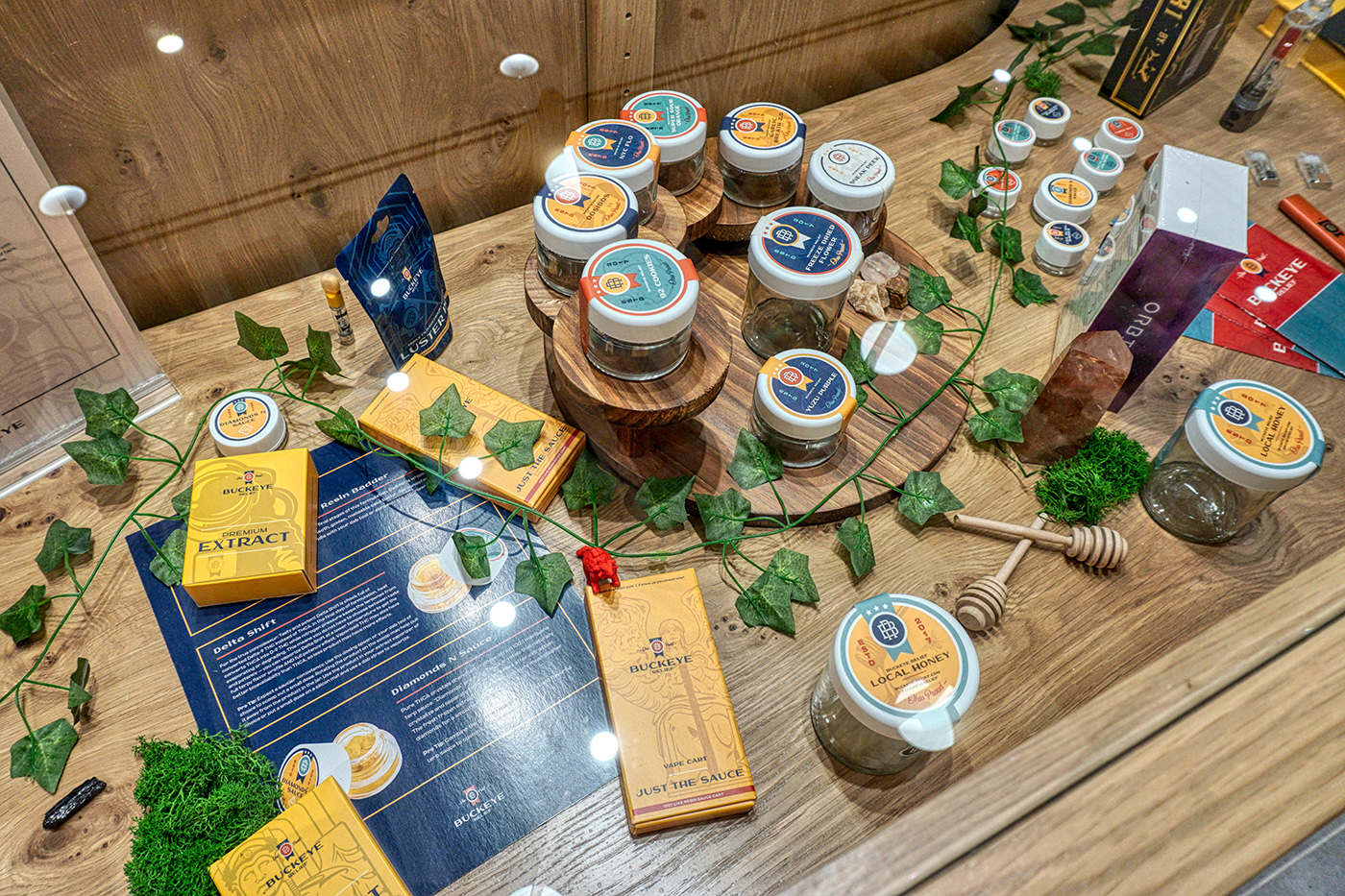
On the gold and recessed-wood-panel shelves around the perimeter of the shop floor, Amplify showcases nationally recognized brands like Timeless Vapes, Tyson 2.0, Old Pal, Kiva, and Wana, as well as the Midwest’s favorite purveyors of loud, Galenas. But despite boasting a packed menu of highly regarded big names, there’s one brand for which customers line up.
“I’m very happy to say Buckeye Relief is our top-selling brand,” said AJ Caraballo, Amplify’s director of retail. On Reddit’s r/OhioMarijuana board—a treasure trove of consumer sentiment in the Midwest—the brand’s ounce and half-ounce packs are beloved for their quality, consistency, and price.
Caraballo added other big movers include products from Green Thumb Industries and PharmaCann, two of the major multistate operators that are bullish on Ohio’s potential as a giant recreational market in the making.
Adult use will be on the ballot in Ohio this November, and the mood throughout the industry is cautiously optimistic now that the state’s medical program has exceeded expectations. Should the measure pass, patient education will become a central tenet for every store in the state, as many Ohioans will venture into dispensaries to purchase legal cannabis for the first time. Amplify is ready for the challenge. Education was a core consideration in the stores’ design.

“When you open in a medical market, you have to undertake the responsibility of educating people,” said Caraballo. “All of these products and brands are new to everyone when they first walk through the door.” Over time, he added, the store’s patient experience naturally has become less education-focused and more personalized as customers become more familiar with the products.
“We are fully aware that if adult use does come around the corner, the needs of our patients are going to change again, and it’s going to mean a lot more reeducation,” he said. “We very much wanted to design a store that was adaptable to those different needs over time.”
But the truly unique education program at Amplify is one that seeks to familiarize patients with the history of Ohio, more specifically Buckeye Relief’s hometown of Cleveland. The once-great city spent much of the twentieth century as a major industrial engine of the American economy, producing automobiles, steel, and clothing. Its demise, Rayburn said, was cemented in 1969 when the Cuyahoga River infamously caught fire thanks to industrial waste dumped by local factories. The ensuing three decades saw Cleveland’s population decline by 47 percent. The city subsequently became synonymous with the death of American manufacturing and the butt of innumerable jokes on television programs like the Emmy-winning comedy-variety shows Laugh In and The Tonight Show Starring Johnny Carson.
The past twenty years have seen the city enjoy a renaissance. Today, Cleveland teems with bars, farm-to-table restaurants, galleries, and museums, the latter being the fruit of generous endowments the city’s wealthy industrialists established more than a century ago.
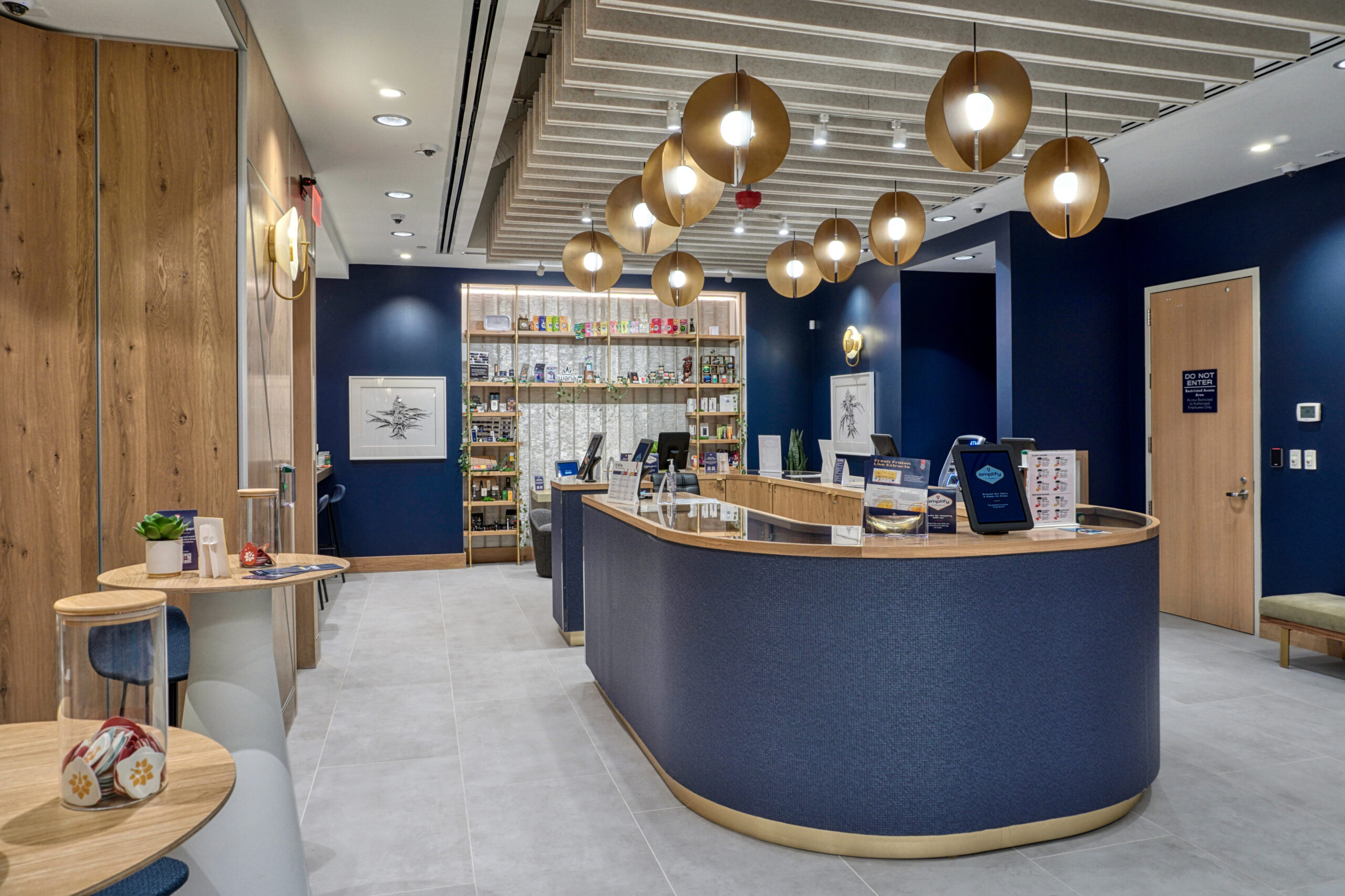
Cleveland has “emerged anew,” Rayburn wrote in a description of a cubist sculpture crafted from dissected cellos by local artist Daniel Roth. The art piece hangs on the Cleveland store’s wall.
As Rayburn and the Buckeye Relief team see it, the company is a manifestation of many things central to Cleveland’s and Ohio’s ever-evolving identities. The company is an innovative startup that serves a diverse patient base and places culture, local pride, and community values at its core. Plenty of companies adopt the Starbucks model of hanging local art on the walls in high-performing stores to “better reflect the community,” but Amplify authentically taps into the foundational pride and reverence of place that emanate from Ohio. The atmosphere could not be imitated easily by companies from out of state, Rayburn said.
“There’s something in being underestimated that is a powerful motivation to exceed everyone’s expectations,” she said.
